Civics: Citizenship
Becoming a Citizen ![]() Citizen Rights
Citizen Rights ![]() Citizen Responsibilities
Citizen Responsibilities ![]() Volunteering
Volunteering

Becoming a Citizen
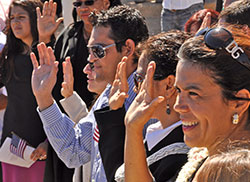 To be able to vote, hold public office, or serve on a jury, a person must be a United States citizen. Citizenship may be acquired in one of two ways; either as a natural citizen or a naturalized citizen. Those who obtain their citizenship at birth are referred to as natural citizens, while those who become citizens at some time after their birth are referred to as naturalized citizens.
To be able to vote, hold public office, or serve on a jury, a person must be a United States citizen. Citizenship may be acquired in one of two ways; either as a natural citizen or a naturalized citizen. Those who obtain their citizenship at birth are referred to as natural citizens, while those who become citizens at some time after their birth are referred to as naturalized citizens.
Natural citizens can be subdivided into two groups; those who acquired their citizenship by having been born in the United States, and those who acquired their citizenship by been born to parents that are citizens of the United States. Those individuals who are born on U.S. soil are said to have received their citizenship under the doctrine of "jus soli" or by the "right of the land". Natural citizens who are not born within the United States, but who are born from parents who were citizens of the United States at the time of their birth acquire their citizenship under the "jus sanguinis" doctrine or by the "right through blood".
The process by which people from foreign countries become U.S. citizens is called naturalization. There are three steps in this process:
- File an application.
- Take a naturalization examination.
- Participate in an Oath Ceremony
Not everyone, however, is eligible to become a naturalized U.S. citizen. A person must meet certain requirements:
- Be at least 18 years old
- A lawful permanent resident for five years
- A person of good moral character
- Be able to understand, read, write, and speak basic English
- Possess a basic understanding of United States government and history
- Be willing to take an oath of allegiance to the United States
Additional eligibility details can be found on the Immigration and Naturalization Service web site. In addition, the INS has provided this eligibility worksheet (pdf) to help people determine if they are eligible to apply for naturalization.
Application for Naturalization
 All applicants must complete the "Application for Naturalization" (Form N-400) to become naturalized. This form can be downloaded off of the INS web site or it can be obtained from a local Immigration and Naturalization Service (INS) office. To discover where the closest INS office is to you, use the INS online map.
All applicants must complete the "Application for Naturalization" (Form N-400) to become naturalized. This form can be downloaded off of the INS web site or it can be obtained from a local Immigration and Naturalization Service (INS) office. To discover where the closest INS office is to you, use the INS online map.
The application requests information such as name, address, date of birth, basis for eligibility, absences from the U.S., employer information, marital history, information about children, allegiance to the U.S. and more.
All applicants must be fingerprinted by the INS (Immigration and Naturalization Service) for the purpose of conducting FBI criminal background checks. The INS charges $32.49 per person (for most applicants) at the time of filing for this fingerprinting service.
Applicants must include the following with their Application for Naturalization:
- Two identical color passport-style photographs
- Evidence and supporting documents
- The filing fee for Form N-400
- A biometric services fee is also required for applicants under 75 years of age when filing Form N-400 regardless of where the applicant lives and whether the applicant is filing from within the United States or abroad.
Naturalization Examination
 After
the Application for Naturalization has been filed, applicants
will be notified to appear at a INS office to be interviewed.
The applicant will be asked questions about his/her application
and some questions that will examine his/her knowledge and
understanding of U.S. history and government.
After
the Application for Naturalization has been filed, applicants
will be notified to appear at a INS office to be interviewed.
The applicant will be asked questions about his/her application
and some questions that will examine his/her knowledge and
understanding of U.S. history and government.
Do you think you would be able to pass this exam? Find out by taking the online Naturalization Self Test or viewing the Sample Questions (pdf). Below are a few of the questions applicants may be asked:
- What is the legislative branch of our government?
- Who was Martin Luther King, Jr.?
- Who is the Commander in Chief of the U.S. military?
- Who is the Chief Justice of the Supreme Court today?
During this interview, applicants will also be examined on their ability to read, write, and speak English. The following applicants do not have to complete this part of the exam:
- Individuals who are more than 50 years of age and who have been lawful permanent residents for 20 years or more.
- Individuals who are more than 55 years of age and who have been lawful permanent residents for 15 years or more.
Oath Ceremony
If one's Application for Naturalization is approved, then the next step to becoming a citizen is to take the Oath of Allegiance to the United States.
"I hereby declare, on oath, that I absolutely and entirely renounce and abjure all allegiance and fidelity to any foreign prince, potentate, state or sovereignty, of whom or which I have heretofore been a subject or citizen; that I will support and defend the Constitution and laws of the United States of America against all enemies, foreign and domestic; that I will bear true faith and allegiance to the same; that I will bear arms on behalf of the United States when required by the law; that I will perform noncombatant service in the armed forces of the United States when required by the law; that I will perform work of national importance under civilian direction when required by the law; and that I take this obligation freely without any mental reservation or purpose of evasion; so help me God."
If an individual cannot promise to bear arms or perform noncombatant service because of religious training and belief, he/she may omit those statements when taking the oath.
In some places, one can choose to take the Oath the same day as the interview, or to request to be scheduled for an oath ceremony in a court.
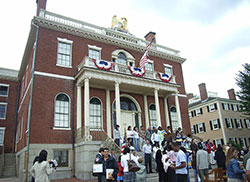 Citizenship Day
Citizenship Day
On February 29, 1952, President Harry S. Truman signed a bill establishing September 17 as Citizenship Day; a day to recognize and honor citizens. September 17 is also the date on which the United States Constitution was signed in 1787.

Citizen Rights
 The Declaration
of Independence, the Constitution and the Bill
of Rights (the first ten amendments to the Constitution)
reflect the United States founders' desire for individual freedom
and their opposition to the centralization of power. The Declaration
contains the founders' belief that there are certain truths:
that we are all created equal, that we have the unalienable
right to life, liberty and the pursuit of happiness and that
the right to govern comes from the consent of the people. The
Constitution explains the roles of the legislative, executive,
and judicial branches of government and provides a system of checks and balances
among these branches. Specific civil liberties and rights not
mentioned in the Constitution are spelled out in the Bill of
Rights. These documents reflect the founders' desire to preserve
individual political freedoms.
The Declaration
of Independence, the Constitution and the Bill
of Rights (the first ten amendments to the Constitution)
reflect the United States founders' desire for individual freedom
and their opposition to the centralization of power. The Declaration
contains the founders' belief that there are certain truths:
that we are all created equal, that we have the unalienable
right to life, liberty and the pursuit of happiness and that
the right to govern comes from the consent of the people. The
Constitution explains the roles of the legislative, executive,
and judicial branches of government and provides a system of checks and balances
among these branches. Specific civil liberties and rights not
mentioned in the Constitution are spelled out in the Bill of
Rights. These documents reflect the founders' desire to preserve
individual political freedoms.
The First Amendment of the United States Constitution protects the right to freedom of religion and freedom of expression from government interference. Freedom of expression is made up of the explicit rights of freedom of speech, press, assembly and to petition the government for a redress of grievances. During the two centuries since the adoption of the First Amendment, the Supreme Court and lower courts have attempted to interpret and define these freedoms through various court cases. It should be noted that these freedoms apply to all people who live in the United States, not just U.S. citizens.
Freedom of Religion
 The First Amendment guarantee of freedom of religion was established because many of the colonists who founded the United States came to America to escape religious persecution and government oppression. This country's founders wanted to prevent any one religion from dominating the government or imposing its will or beliefs on society as a whole. Two clauses in the First Amendment guarantee freedom of religion. The first part of this provision is known as the Establishment Clause, and the second part is known as the Free Exercise Clause. The establishment clause prohibits the government from passing laws that will establish an official religion or preferring one religion over another. The courts have interpreted the establishment clause to accomplish the separation of church and state.
The First Amendment guarantee of freedom of religion was established because many of the colonists who founded the United States came to America to escape religious persecution and government oppression. This country's founders wanted to prevent any one religion from dominating the government or imposing its will or beliefs on society as a whole. Two clauses in the First Amendment guarantee freedom of religion. The first part of this provision is known as the Establishment Clause, and the second part is known as the Free Exercise Clause. The establishment clause prohibits the government from passing laws that will establish an official religion or preferring one religion over another. The courts have interpreted the establishment clause to accomplish the separation of church and state.
The free exercise clause prohibits the government from interfering with a persons practice of their religion. However, religious actions and rituals can be limited by civil and federal laws. For example, the 1878 Supreme Court case Reynolds v. United States found that the federal law prohibiting polygamy, which was challenged by a Mormon defendant, was constitutional. Polygamy was outlawed.
Freedom of Speech
 Freedom
of speech is the right to speak out publicly or privately.
This covers all forms of expression, including newspapers,
magazines, books, television, radio, movies, and electronic
documents. While the right to free speech is not absolute,
its protection is broad. For example, it protects silence
(e.g., right to refrain from reciting the Pledge
of Allegiance), symbolic speech (e.g., the right to
burn an American flag in protest), intellectual freedom
(e.g., right to read). In most cases the First Amendment,
does not protect speech that incites or provokes extreme
violence. For example, it is illegal to yell "Fire!" in
a movie theater. Be sure to check out the recent
Supreme Court decisions that have to do with freedom
of speech.
Freedom
of speech is the right to speak out publicly or privately.
This covers all forms of expression, including newspapers,
magazines, books, television, radio, movies, and electronic
documents. While the right to free speech is not absolute,
its protection is broad. For example, it protects silence
(e.g., right to refrain from reciting the Pledge
of Allegiance), symbolic speech (e.g., the right to
burn an American flag in protest), intellectual freedom
(e.g., right to read). In most cases the First Amendment,
does not protect speech that incites or provokes extreme
violence. For example, it is illegal to yell "Fire!" in
a movie theater. Be sure to check out the recent
Supreme Court decisions that have to do with freedom
of speech.
Freedom of the Press
The courts have long struggled to determine whether the framers of the Constitution intended to differentiate press freedom from speech freedom. Most have concluded that freedom of the press derives from freedom of speech. Freedom of the press allows an individual to express themselves through publication. The Court has generally rejected requests to extend to the press privileges beyond those available to ordinary citizens.
The Right to Assemble
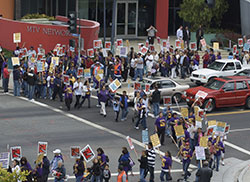 Freedom of assembly is the right of people to gather peacefully to exchange ideas or to peacefully protest social, economic, or political conditions and demand reform. Most public gatherings in the United States proceed without active interference by police or other officials. But sometimes police officers may make arrests when demonstrations threaten to turn violent. The right to assemble, however is not an absolute right. Most towns and cities can legally regulate the time, place, and manner of assembling. For example, a city may restrict a large demonstration to a particular area or time of day.
Freedom of assembly is the right of people to gather peacefully to exchange ideas or to peacefully protest social, economic, or political conditions and demand reform. Most public gatherings in the United States proceed without active interference by police or other officials. But sometimes police officers may make arrests when demonstrations threaten to turn violent. The right to assemble, however is not an absolute right. Most towns and cities can legally regulate the time, place, and manner of assembling. For example, a city may restrict a large demonstration to a particular area or time of day.
The Right to Petition
The right to petition the government for a redress of grievances guarantees people the right to ask the government to provide relief for a wrong through the courts or other governmental action. It works with the right of assembly to allow people to join together to seek change from the government.
Additional Freedoms
The First Amendment is not the only change or addition to the Constitution that defines citizens' rights. Some of the other amendments in the Bill of Rights also define citizens' rights, such as the right to bear arms and the right to a trial by jury. (To learn more about the Bill of Rights, go to the Historical Documents section of this web site.)
The Rights of Black Americans
 It was noted above that the Declaration of Independence, states "That all men are created equal..." But in 1776 when this document was written, many blacks in America were enslaved. It took almost ninety years for the United States government to end slavery. Black Americans made significant gains in their struggle for equal rights during the Reconstruction, the 12-year period after the American Civil War. The 13th Amendment, adopted in 1865, abolished slavery in the United States. In 1868, the 14th Amendment made the former slaves citizens. It also guaranteed to all people "equal protection of the laws." The 15th Amendment, which became law in 1870, did not expressly grant black citizens the right to vote, but prohibited state and federal governments from denying this right based on "race, color, or previous condition of servitude."
It was noted above that the Declaration of Independence, states "That all men are created equal..." But in 1776 when this document was written, many blacks in America were enslaved. It took almost ninety years for the United States government to end slavery. Black Americans made significant gains in their struggle for equal rights during the Reconstruction, the 12-year period after the American Civil War. The 13th Amendment, adopted in 1865, abolished slavery in the United States. In 1868, the 14th Amendment made the former slaves citizens. It also guaranteed to all people "equal protection of the laws." The 15th Amendment, which became law in 1870, did not expressly grant black citizens the right to vote, but prohibited state and federal governments from denying this right based on "race, color, or previous condition of servitude."
Although these amendments helped to strengthen the rights of Blacks in America, they were not successful in ending racial discrimination and injustice. During the late 1870's, white Americans increasingly disregarded the newly won rights of black Americans. In 1896, in the Supreme Court case of Plessy v. Ferguson, upheld a Louisiana law requiring separate but equal accommodations for blacks and whites in railroad cars. Many Southern states used the "separate but equal" rule established in this case to segregate the races in public schools, establishments and transportation for over 50 years.
In 1954, the Supreme Court case Brown v. Board of Education established that segregation in the public schools was a violation of the 14th Amendment to the Constitution. This event is sometimes noted as the first step in the Civil Rights Movement. Ten years later, the Civil Rights Act of 1964 was passed. This law bans discrimination because of a person's color, race, national origin, religion, or sex. The act primarily protects the rights of blacks and other minorities. It is one of the nation's strongest civil rights laws. The following resources describe the important people and events of the Civil Rights movement.
- African American Odyssey: A Quest for Full Citizenship - the story of African Americans from the end of slavery through the Civil Rights era.
- Civil Rights Timeline
- A Civil Rights Photo Tour
- National Civil Rights Museum
- School Desegregation - read about the first African Americans to attend Little Rock's Central High
- Listen to Martin Luther King Jr.'s "I have a Dream" speech
The Rights of All Americans
African Americans, of course, are not the only group in America's history that faced injustice. For example, American Indians were not granted citizenship rights until 1924, and it took until 1948 for some states to allow Native Americans to vote. Women did not have the right to vote until 1920, when the 19th Amendment was ratified. (To learn more about voting rights go to the Elections section of this web site.)
In recent times, legislation has focused less on the rights of ethnic and racial groups. In 1980 the Civil Rights of Institutionalized Persons Act ensured that the rights of persons in institutions, such as government-run hospitals, nursing homes and prison, are protected against unconstitutional conditions. The Americans with Disabilities Act of 1990 (ADA) has helped strengthen the rights people with disabilities.

Citizen Responsibilities
The duties or responsibilities of a United States citizen can be separated into two groups: mandatory duties, such as paying taxes, and responsibilities not demanded by law, such as voting.
 Mandatory: Obeying Laws
Mandatory: Obeying Laws
Laws are the rules under which a society or community is governed. Everyone who lives in the United States, regardless if they are citizens or not, must obey federal, state and local laws. Laws are necessary because no society could exist if all people did just as they pleased, without respecting the rights of others. Police officers and courts make sure that laws are obeyed. If a person breaks a law there is a penalty or punishment. The penalty for breaking a law depends on the law. For example, the punishment for not shoveling your sidewalk after it snows is less steep than the punishment for stealing a car. Take a moment to search or browse through the current United States Code and the Utah Code.
Mandatory: Paying Taxes
 Taxes are required payments of money to the government. You
may be wondering why
we pay taxes (pdf). Taxes are necessary because they pay for
things that most individuals could not possibly purchase for
themselves, such a fire protection, schools, roads and much
more.
Taxes are required payments of money to the government. You
may be wondering why
we pay taxes (pdf). Taxes are necessary because they pay for
things that most individuals could not possibly purchase for
themselves, such a fire protection, schools, roads and much
more.
There are many different types of taxes: federal income tax, state income tax, property tax, excise tax (tax on tobacco, alcohol, gas), social security tax and sales tax. Each type of tax pays for different public programs and services. For example, federal taxes pay for F.B.I. agents, Medicare doctors, federal judges, national park rangers, veterans benefits, federal prisons and much more. Some of the things that state taxes pay for include state highways, universities, public schools, state parks and police officers.
To learn more about taxes visit these web sites:
Mandatory: Jury Duty
 The right to a trial by jury is the privilege of every person in the United States, whether citizen or not. This right is guaranteed by both the United States and Utah Constitutions. However, it also requires that citizens give of their time to serve as jurors, and thus do their part to protect this American right. A jury consists of 12 people who are selected to hear the evidence in a civil or a criminal trial. After the jurors hear the evidence presented during the trial, they must try to decide if the defendant is guilty or not guilty.
The right to a trial by jury is the privilege of every person in the United States, whether citizen or not. This right is guaranteed by both the United States and Utah Constitutions. However, it also requires that citizens give of their time to serve as jurors, and thus do their part to protect this American right. A jury consists of 12 people who are selected to hear the evidence in a civil or a criminal trial. After the jurors hear the evidence presented during the trial, they must try to decide if the defendant is guilty or not guilty.
While being called to jury duty can be viewed as an inconvenience, many citizens also find it to be a learning process and a rewarding experience as well as a civic responsibility. Jurors' names are selected at random from lists of registered voters and individuals who have a driver's license issued by the Utah Department of Motor Vehicles. If an individual is chosen for jury duty, he or she must stop work and attend the trial as long as he or she is needed. Every American of legal age is subject to jury duty, unless he or she can show that such service would constitute a severe personal hardship.
Mandatory: Serve as a Witness
If you are subpoenaed or summoned to serve as a witness you must comply. A witness is someone who is called to testify under oath in a court trial or hearing about information or knowledge he or she might have about the case.
Mandatory: Register for the Draft
 Virtually
all males living in the United States are required to register
with Selective Service within 30 days of their 18th birthday.
Currently, women aren't required to register because the Selective
Service law refers specifically to "male persons"
in stating who must register and who would be drafted. Congress
would have to amend the law for women to be required to register
with Selective Service.
Virtually
all males living in the United States are required to register
with Selective Service within 30 days of their 18th birthday.
Currently, women aren't required to register because the Selective
Service law refers specifically to "male persons"
in stating who must register and who would be drafted. Congress
would have to amend the law for women to be required to register
with Selective Service.
Registering does not mean a man will automatically be taken into the military. During times of crisis or war, the government may decide that they need larger military forces than they feel they could get through voluntary enlistment. If this happens the Selective Service will:
- Conduct a lottery to determine the sequence for selecting registrants for examination and induction.
- Assign each registrant the Random Sequence Number (RSN) drawn by lottery for his date of birth.
- Select and order registrants for examination and induction, beginning with RSN 001. Those selected are examined for mental, physical and moral fitness.
Today, males can register online at the Selective Service web site or at their local Post Office.
 Voluntary: Voting
Voluntary: Voting
The right to vote is a duty or responsibility as well as a privilege. It is important for all citizens to vote in every election to make sure that the democratic, representative system of government is maintained. Persons who do not vote lose their voice in the government. Before voting in an election, each citizen should be well informed about the issues and candidates.

Volunteering
Many Americans of all ages choose to contribute their time and talents in support of causes in which they believe. Volunteer projects include being a chaperone on a school field trip, active membership on the parent-teacher association, participating in town meetings, and working to improve the living conditions of the poor. The idea that ordinary people, can do extraordinary things when they work together as a group in service to others, is a powerful one. Below is a list of volunteer projects and organizations for both students and adults.
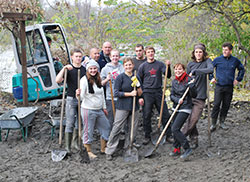 Student Social Action Projects
Student Social Action Projects
- The Earth Day Project
To celebrate Earth Day students decorate paper grocery bags with pro-environmental messages, and give them to stores to use to hold customers' groceries. - Save
Our Beach
In this project, students pick up litter at local beaches, which they then analyze and categorize. Students use email to share the data with participating schools. The project then encourages students to draw conclusions from the data and discuss ways they can reduce pollution. - Nonprofit Prophets
This is an interactive project that challenges groups of students to investigate a problem that they see in the world, and then create a World Wide Web Resource page on the Internet that teaches the world about the problem. Typically, students collaborate with local non-profit agencies that need a web site. - Rainforest
Action Network
Find out what you can do to help save the rainforest.
Student Community Service Projects
 Do Something
Do Something
Do Something is a national non-profit organization that inspires young people to believe that change is possible, and trains, funds and mobilizes them to be leaders who measurably strengthen their communities. They offer $500 grants to youth under 30 to implement service projects in their communities. Stop by this site for a grant application and to find out more about the many other programs they sponsor.- Youth Service America
Enter your zip code to find volunteer opportunities in your community. - Kids Can Make a Difference
Kids Can Make A Difference® (KIDS), an educational program for middle and high school students, focuses on the root causes of hunger and poverty, the people most affected, solutions, and how students can help. The major goal is to stimulate the students to take some definite follow-up actions as they begin to realize that one person can make a difference. The best click, however, is the What Kids Can Do page. 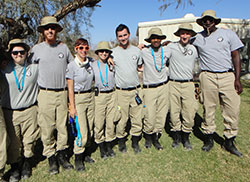 AmeriCorps
AmeriCorps
The young people in AmeriCorps work in one of 430 programs designed to meet specific community needs in four areas: education, public safety, human services, and the environment. Volunteers tutor elementary school students, start neighborhood crime watches, provide companionship to the elderly, and restore coastlines, among other things.- Corporation
for National and Community Service
The Corporation for National Service is the private-public partnership which oversees such agencies as Learn and Serve America, AmeriCorps, National Civilian Conservation Corps and SeniorCorps. You can find out about new funding initiatives, as well as locate general resources on service-learning here. - Help the Homeless
This site teaches kids who the homeless are and what they can do to help them.
Adult Volunteer Opportunities
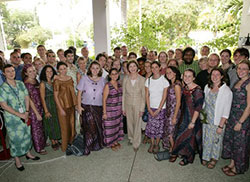 Peace Corps
Peace Corps
Peace Corps is an independent overseas volunteer program of the United States government. Men and women in the Peace Corps work with people in developing countries to help them improve their living conditions. The chief goals of the corps are (1) to help the poor obtain everyday needs, (2) to promote world peace, and (3) to increase understanding between Americans and the people of other nations.- Red Cross
Red Cross is an organization that works to relieve human suffering and has more than 10 million volunteers, including blood donors and students. The programs and services of the American Red Cross are funded by voluntary contributions. - Habitat for
Humanity
Volunteers apply hands-on solutions to the need for affordable housing. Together with low-income individuals needing a place of their own, individuals donate their time to build "simple, decent homes."


 UTAH EDUCATION NETWORK
UTAH EDUCATION NETWORK

 Justin
Justin Braxton
Braxton Dani
Dani Kayla
Kayla Katie
Katie Lora
Lora Rob
Rob Val
Val

